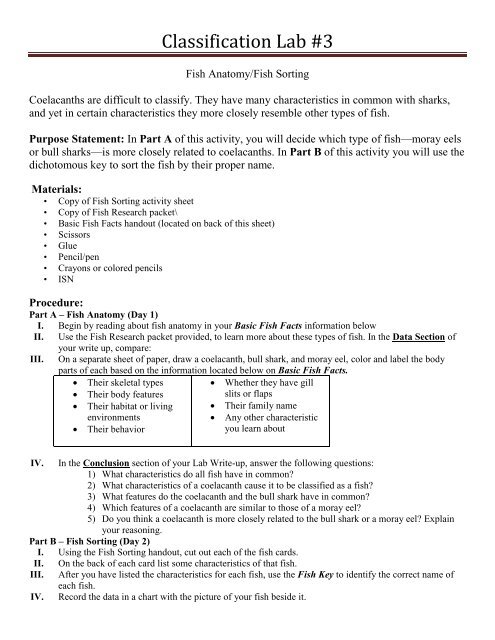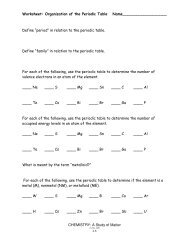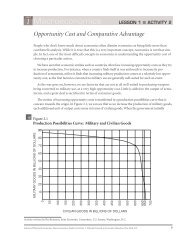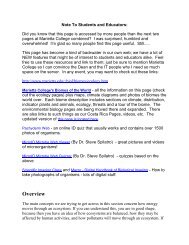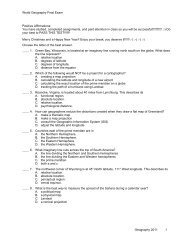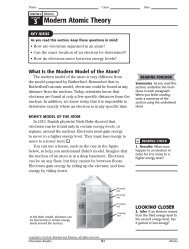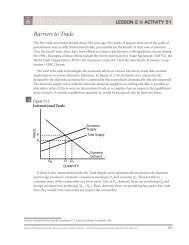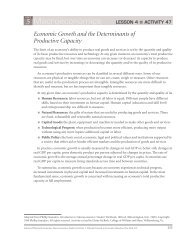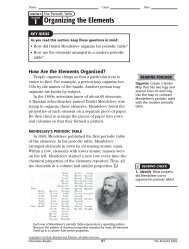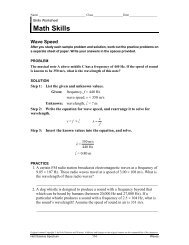Classification Lab #3
Classification Lab #3
Classification Lab #3
You also want an ePaper? Increase the reach of your titles
YUMPU automatically turns print PDFs into web optimized ePapers that Google loves.
<strong>Classification</strong> <strong>Lab</strong> <strong>#3</strong>Fish Anatomy/Fish SortingCoelacanths are difficult to classify. They have many characteristics in common with sharks,and yet in certain characteristics they more closely resemble other types of fish.Purpose Statement: In Part A of this activity, you will decide which type of fish—moray eelsor bull sharks—is more closely related to coelacanths. In Part B of this activity you will use thedichotomous key to sort the fish by their proper name.Materials:• Copy of Fish Sorting activity sheet• Copy of Fish Research packet\• Basic Fish Facts handout (located on back of this sheet)• Scissors• Glue• Pencil/pen• Crayons or colored pencils• ISNProcedure:Part A – Fish Anatomy (Day 1)I. Begin by reading about fish anatomy in your Basic Fish Facts information belowII. Use the Fish Research packet provided, to learn more about these types of fish. In the Data Section ofyour write up, compare:III. On a separate sheet of paper, draw a coelacanth, bull shark, and moray eel, color and label the bodyparts of each based on the information located below on Basic Fish Facts. Their skeletal types Whether they have gill Their body featuresslits or flapsTheir habitat or livingenvironmentsTheir behaviorTheir family nameAny other characteristicyou learn aboutIV. In the Conclusion section of your <strong>Lab</strong> Write-up, answer the following questions:1) What characteristics do all fish have in common?2) What characteristics of a coelacanth cause it to be classified as a fish?3) What features do the coelacanth and the bull shark have in common?4) Which features of a coelacanth are similar to those of a moray eel?5) Do you think a coelacanth is more closely related to the bull shark or a moray eel? Explainyour reasoning.Part B – Fish Sorting (Day 2)I. Using the Fish Sorting handout, cut out each of the fish cards.II. On the back of each card list some characteristics of that fish.III. After you have listed the characteristics for each fish, use the Fish Key to identify the correct name ofeach fish.IV. Record the data in a chart with the picture of your fish beside it.
<strong>Classification</strong> <strong>Lab</strong> <strong>#3</strong>Basic Fish FactsG i l l s : Allow a fish to breathe. Some fishes have gills covered by flaps. When a fish opens itsmouth, the flap closes, drawing water into the mouth. As the fish closes its mouth, the flap opens.Oxygen is extracted from the water as it passes over the gills. Other fishes have gill slits.Tails: Fish tails also take many shapes. A crescent-shaped tail, like that of the swordfish, allows thefish to swim rapidly through the water. A forked tail, like that of the trout, can also allow fastswimming. A rounded tail, like that of the angelfish, enables quick bursts of speed to escapepredators.Fins: Help a fish move. The top fins are called dorsal fins. If there are two dorsal fins, the one nearestthe head is called the first dorsal fin and the one behind it is the second dorsal fin. The belly or lowerpart of the fish is the ventral region. Within this section is the pectoral fin, which is located near thegills, and the pelvic fin, which may have a more specific name depending on its position in the ventralregion. The bottom fin at the back of the fish is called the anal fin. The tail fin is called the caudal fin.Pectoral and pelvic fins come in pairs. Dorsal, anal, and caudal fins are single.Mouths: Enable a fish to eat. Some mouths extend directly from the head of the fish; in others thelower jaw extends beyond the upper jaw. Some mouths are on the underside of a fish’s head, whileothers are more snout-like and suck in food.B o d i e s : The shape of a fish’s body depends on the fish’s habits. For example, the body may bestreamlined for faster swimming, as in the barracuda. They may be flattened from side to side, as inthe angelfish, allowing them to maneuver in narrow spaces. Fishes that are flattened from top tobottom, such as the stingray, live on the seafloor. Other fishes are snake-like, such as the eel,enabling them to move easily between rocks. Other fishes have their own unique shapes.


